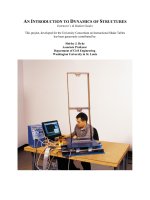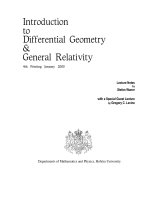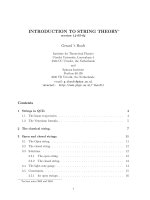Lecture physics a2 intro to nuclear physics huynh quang linh
Bạn đang xem bản rút gọn của tài liệu. Xem và tải ngay bản đầy đủ của tài liệu tại đây (509.3 KB, 10 trang )
Intro to Nuclear Physics
1
Nuclear Physics Topics
Composition of Nucleus
features of nuclei
Nuclear Models
nuclear energy
Fission
Fusion
Summary
2
About Units
Energy - electron-volt
1 electron-volt = kinetic energy of an electron when
moving through potential difference of 1 Volt;
o 1 eV = 1.6 ì 10-19 Joules
o 1 kWãhr = 3.6 × 106 Joules = 2.25 × 1025 eV
o 1 MeV = 106 eV, 1 GeV= 109 eV, 1 TeV = 1012 eV
mass - eV/c2
o
o
o
o
1 eV/c2 = 1.78 × 10-36 kg
electron mass = 0.511 MeV/c2
proton mass = 938 MeV/c2 = 0.938 GeV/ c2
neutron mass = 939.6 MeV/c2
momentum - eV/c:
o 1 eV/c = 5.3 × 10-28 kg m/s
o momentum of baseball at 80 mi/hr 5.29 kgm/s 9.9 × 1027
eV/c
Distance
o 1 femtometer (“Fermi”) = 10-15 m
3
Radioactivity
Discovery of Radioactivity
Antoine Becquerel (1896): serendipitous discovery of radioactivity:
penetrating radiation emitted by substances containing uranium
A. Becquerel, Maria Curie, Pierre Curie(1896 – 1898):
o also other heavy elements (thorium, radium) show radioactivity
o three kinds of radiation, with different penetrating power
(i.e. amount of material necessary to attenuate beam):
“Alpha (a) rays” (least penetrating – stopped by paper)
“Beta (b) rays” (need 2mm lead to absorb)
“Gamma (g) rays” (need several cm of lead to be attenuated)
o three kinds of rays have different electrical charge:
a: +, b: -, g: 0
Identification of radiation:
Ernest Rutherford (1899)
o Beta (b) rays have same q/m ratio as electrons
o Alpha (a) rays have same q/m ratio as He
o Alpha (a) rays captured in container show He-like emission spectrum
4
Proton
“Canal rays”
1898: Wilhelm Wien:
opposite of “cathode rays”
Positive charge in
nucleus (1900 – 1920)
Atoms are neutral
o positive charge needed to cancel electron’s negative charge
o Rutherford atom: positive charge in nucleus
periodic table realized that the positive charge of
any nucleus could be accounted for by an integer
number of hydrogen nuclei -- protons
5
Neutron
Walther Bothe 1930:
bombard light elements (e.g. 49Be) with alpha particles
neutral radiation emitted
Irène and Frederic Joliot-Curie (1931)
pass radiation released from Be target through paraffin wax
protons with energies up to 5.7 MeV released
if neutral radiation = photons, their energy would have to be 50
MeV -- puzzle
puzzle solved by James Chadwick (1932):
“assume that radiation is not quantum radiation, but a neutral
particle with mass approximately equal to that of the proton”
identified with the “neutron” suggested by Rutherford in 1920
observed reaction was:
a (24He++) + 49Be 613C*
13
612C + n
6 C*
6
Beta decay -- neutrino
Beta decay puzzle :
o decay changes a neutron into a proton
o apparent “non-conservation” of energy
o apparent non-conservation of angular momentum
Wolfgang Pauli predicted a light, neutral, feebly
interacting particle (called it neutron, later called
neutrino by Fermi)
7
Positron
Positron (anti-electron)
Predicted by Dirac (1928) -- needed for relativistic
quantum mechanics
existence of antiparticles doubled the number of
known particles!!!
Positron track going
upward through lead
plate
P.A.M. Dirac
Nobel Prize (1933)
member of FSU faculty
(1972-1984)
one of the greatest physicists of the 20th century
8
Structure of nucleus
size (Rutherford 1910, Hofstadter 1950s):
R = r0 A1/3, r0 = 1.2 x 10-15 m = 1.2 fm;
i.e. ≈ 0.15 nucleons / fm3
generally spherical shape, almost uniform density;
made up of protons and neutrons
protons and neutron -- “nucleons”;
are fermions (spin ½), have magnetic moment
nucleons confined to small region (“potential well”)
occupy discrete energy levels
two distinct (but similar) sets of energy levels,
one for protons, one for neutrons
proton energy levels slightly higher than those of
neutrons (electrostatic repulsion)
spin ½ Pauli principle
only two identical nucleons per eng. level
9
Nuclear Sizes - examples
1
3
r ro (A )
ro = 1.2 x 10-15 m
Find the ratio of the radii for the following nuclei:
1H, 12C, 56Fe, 208Pb, 238U
1
3
1
3
1
3
1
3
1
3
1 : 12 : 56 : 208 : 238
1 : 2.89 : 3.83 : 5.92 : 6.20
10









